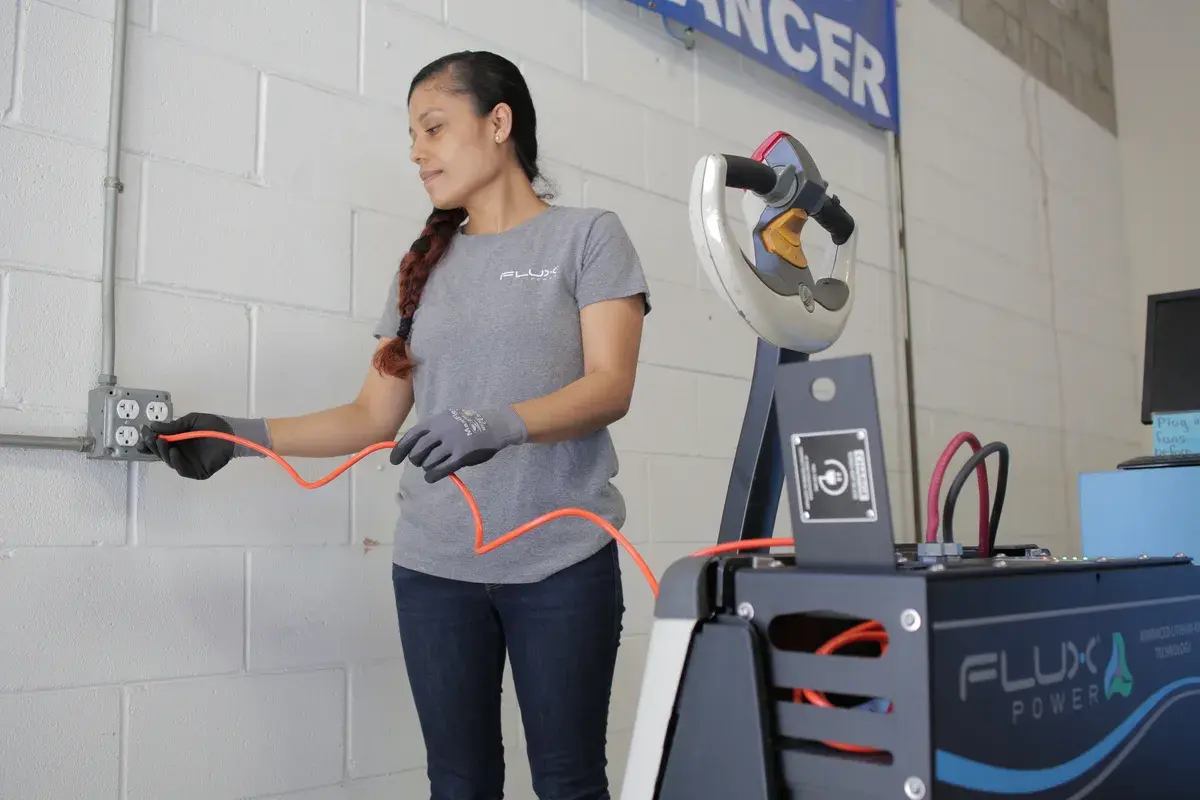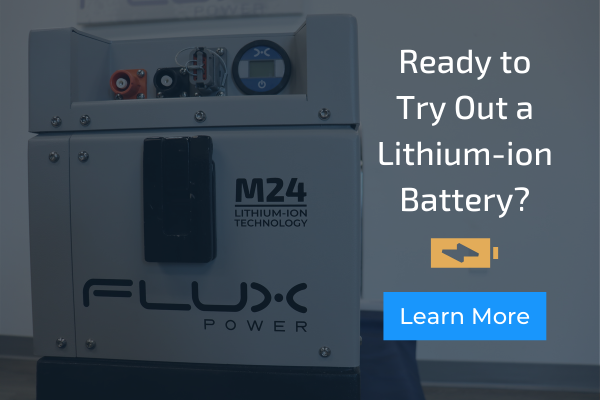Forklift Battery Charging Procedure
Charging practices have a significant impact on battery runtime and lifespan. Depending on what type of battery powers the equipment, the charging methods can have a substantial impact.
For industrial batteries, the charger is typically made by a third-party manufacturer and can have a variety of special features depending on the application and usage of the equipment. These features include adaptations for certain temperatures, ‘fast charging’, and more.
The term ‘opportunity charging’ refers to the practice of charging an industrial battery for short periods of time throughout the day, as opposed to charging it in full all at once. In short, you are charging the battery whenever the opportunity arises.
Usually, warehouses use opportunity charging during shift changes, employee lunch breaks or other pauses during the workday. This allows the same battery to be used continuously and eliminating the need for battery swaps.
Opportunity charging is great for saving time and improving productivity for warehouses - but only if it’s used with the right type of battery.
Benefits of Opportunity Charging: Warehouse Optimization
Opportunity charging has revolutionized forklift fleet management because it allows for the continuous use of the same battery throughout multiple shifts.
For a warehouse using multi-shift operations where there is no 8-hour downtime period for battery charging, opportunity charging is the best method to maximize equipment uptime.
The process of changing out depleted lead acid batteries is time-consuming and involves a lot more steps than just plugging a battery into the charger for a few minutes during a break.
Forklift batteries weigh thousands of pounds, so they require special lifting equipment to be removed from the equipment for charging. Additionally, lead acid batteries must be charged in a separate, ventilated room due to the toxic and flammable hydrogen gas that is emitted from them during the charging process.
Eliminating these steps by utilizing opportunity charging saves companies thousands of dollars in lost productivity. Eliminating a separate charging room also allows a company to reclaim warehouse space. This is only possibly with lithium-ion batteries.
Lead acid batteries typically have very specific charging requirements. It is possible for them to sustain a bit of damage to their performance and lifespan when these procedures are not followed to a T.
Considerations for Lead Acid Battery Charging
While opportunity charging is possible with lead acid batteries, it is generally not recommended.
Lead acid batteries experience a drastic decrease in their lifespan when they’re opportunity charged - sometimes as much as a 40% reduction.
Lead acid batteries require specially designed opportunity chargers for this practice because conventional constant current constant voltage (CC CV) chargers will damage the battery if they only deliver a partial charge.
Typically, when utilizing opportunity charging with a lead acid battery, it must receive a full charge once every week to two weeks, to equalize the battery. This is called an equalization charge.
Constant Current Constant Voltage Charging
Constant current constant voltage charging, or CC CV, is the most common type of charging method used for lead acid batteries.
CC CV simply means that the charge current stays the same as the battery’s voltage rises, until the voltage reaches about 80% of the battery’s capacity.
At that pre-set voltage limit, the current automatically drops and charges at a slower rate until the last 20% of the battery’s capacity is filled.
From that point on, some chargers will maintain a float charge, which will simply maintain the battery’s fully charged condition as it naturally self-discharges over time.
This method prevents overheating and overcharging, which can damage any type of battery.
For lead acid batteries, the charging process heats up the battery, so this method requires an additional 6-8 hours of cooldown time after the battery is fully charged.
CC CV charging is widely considered the most ideal method of charging for a lead acid battery because it prevents overcharging and sulfation. Overcharging and sulfation are the primary culprits of damaged lead acid batteries.
Sulfation & Equalization Charge
Allowing lead acid batteries to completely discharge and then fully re-charge is the best way to maintain their lifespan and performance level because it prevents sulfation.
Sulfation is the formation of sulfate crystal deposits on the battery’s plates, which can be from soft and reversible crystalline structures to hard, permanent ones.
These crystals form during the discharge process, but they become permanent and damaging when a lead acid battery is used for too long before receiving a full charge.
It is for this reason that lead acid batteries must always be stored in a fully charged state and must be periodically given a maintenance charge even when not being used due to their constant self-discharge.
Sulfation also occurs when a battery is not given a full charge and instead is repeatedly opportunity charged.
An equalization charge is a slight, calculated overcharge that generates heat within the battery electrolyte and forces current through areas of the plate that have soft crystal build-up, which helps dissolve the crystals and restore the battery to full working condition.
An equalization charge is only effective when the sulfation is still reversible. Once it becomes permanent, the effects can:
- drastically decrease the battery’s lifespan
- increase heat build-up
- shorten the runtime
- lead to complete battery failure
The process of equalization must be calculated precisely. If the battery receives too much voltage, it can also be permanently damaged through overcharging. The most effective way to determine the level of sulfation and reverse it is to send the battery to a specialist, usually the manufacturer.
Why Opportunity Charging Works Best with Lithium-Ion Batteries
The ability to charge a battery whenever it is needed is a simple way to save a company thousands of dollars.
One major equipment manufacturer was calculated a $4,800 cost every single day due to lost productivity when they were having to swap out their lead acid batteries twice per shift. After switching to lithium-ion, they were able to work opportunity charging into their daily processes and ended up saving over $1 million every year by reclaiming that lost productivity.
Lithium-ion batteries do not need to receive a full charge and have no risk of sulfation due to their internal chemistry.
In fact, their lifespan is optimized when they are not fully charged and do better with opportunity charging.
They do not need a complex voltage setup in order to avoid damage during the charging process, and do not require an equalization charge either.
Since lithium-ion batteries can sustain damage when overcharged or overheated, it’s actually better to utilize opportunity charging because it eliminates that risk.
Many companies are using their forklifts more frequently in multi-shift operations to keep up with demand. Lithium-ion battery packs paired with opportunity charging delivers the benefits of saving time and productivity.












